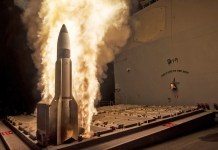On July 3, a Spanish F/A-18 fighter jet intercepted an EasyJet flight bound for Menorca after a British tourist, aged 18, allegedly threatened to detonate a bomb.
In video footage shot by a passenger on the commercial flight, a F/A-18 warplane can be seen flying near the EasyJet flight and ‘swinging in the flight’
According to the Civil Guard, an 18-year-old British man posted a bomb threat on social media, alerting the control tower at Menorca Airport, which led to a particular operation.
The fighter jet “tipped” its wings at the easyJet pilot, indicating “follow me.” After landing in Mahon, the island’s capital, the flight was taken to a location from the main terminal and inspected by bomb-disposal specialists and sniffer dogs. Later, the Civil Guard concluded that the bomb threat was utterly false.
The 18-year-old has since been detained, and it is anticipated that he will receive a bill to pay for the expenses of the police operation and the scrambling of the military jet.
A spokesperson for the Civil Guard said: “The Civil Guard has arrested an 18-year-old British national as the alleged author of a crime of public disorder in Mahon in Menorca.”
“The passengers were disembarked and established protocol followed until police could confirm it was a false bomb threat. The responsible person was identified on social media, and five other companions as witnesses. They were taken to a police station so officers could clarify the situation.”
The 18-year-old was traveling to the holiday island with friends for a celebration.
Interception Procedures
As mentioned earlier, before escorting the aircraft to the airport in Menorca, the fighter “tipped” its wings toward the EasyJet pilot, indicating “follow me.”
According to a standard procedure, all fighter intercepts will occur in a pair, with both aircraft approaching the passenger plane from behind. Then, while the second jet comes and communicates with the civilian captain, the first jet will stay at the tail.
However, it is not unusual for the intercept operation to be carried out by a single aircraft. Meanwhile, the communication can be done via radio or, if the radios aren’t working, by indicating through the window.
A wing-tip maneuver will signal the pilot of the civilian aircraft that they have been intercepted and, therefore, should follow the fighters to the ground. This usually entails landing at the nearest airfield, which may not be the destination port as initially planned, depending on where the intercept occurred along the route.
If the target aircraft doesn’t cooperate, the interceptor may perform a second climbing turn across the target aircraft’s flight path (minimum 500 feet separation and starting from slightly below the target aircraft’s altitude).
It then can release flares as a warning signal to the target aircraft to comply immediately, turn in the required way, and leave the area.
According to European Aviation Safety Agency (EASA) regulations, fighter aircraft should only intercept civilian flight plans as a “last resort.” When a fighter jet intercepts a civilian aircraft, it must adhere to strict protocols.
F-18 Fighter Jet
F-18s are among the most well-known aircraft in the world. The Tom Cruise film “Top Gun” includes scenes involving this fighter jet.
The Spanish Air Force, the Royal Canadian Air Force (CF-18, a variant of the American F/A-18 Hornet), the Finnish Air Force, and the US Marine Corps are a few air forces operating the jets.
The jet can fly at 40,000 feet and reach supersonic speeds of up to 1,190 mph. The aircraft can be armed with various weapons, including air-to-air, anti-ship, and ground-to-air missiles.
It also has a 6-barrel Vulcan cannon and can carry bombs. The F/A-18 Hornet served as the foundation for the more extensive, evolutionary redesign, the Boeing F/A-18E/F Super Hornet.
There are 11 weapon stations on the Super Hornet, including two extra wing store stations, to support a full complement of armaments, such as AIM-9 Sidewinder, AIM-7 Sparrow, and AIM-120 AMRAAM air-to-air missiles.

Additionally, it can use guided air-to-ground weapons like the Maverick, SLAM/SLAM-ER, GBU-10, GBU-51, HARM, and Harpoon, as well as free-fall air-to-ground bombs like the Mk-76, BDU-48, Mk-82LD, Mk-82HD, and Mk-84.
The aircraft is also capable of carrying the GPS/inertially guided JDAM Joint Direct Attack Munition (JDAM), joint stand-off weapon (JSOW), and joint air-to-surface stand-off missile (JASSM).
Two F414-GE-400 turbofan engines from General Electric are outfitted to power the new variants of the aircraft F/A-18E/F. The air inlets have also been widened to increase engine airflow. With an afterburner, each engine can reach a top speed of more than Mach 1.8 while producing 22,000 lb of thrust each.
The F/E variant of the aircraft has an internal fuel capacity of 3,600 lb higher than the F-18C/D variant, thanks to structural changes to the airframe. It increases the mission radius by up to 40%.
- Contact the author at ashishmichel@gmail.com
- Follow EurAsian Times on Google News





